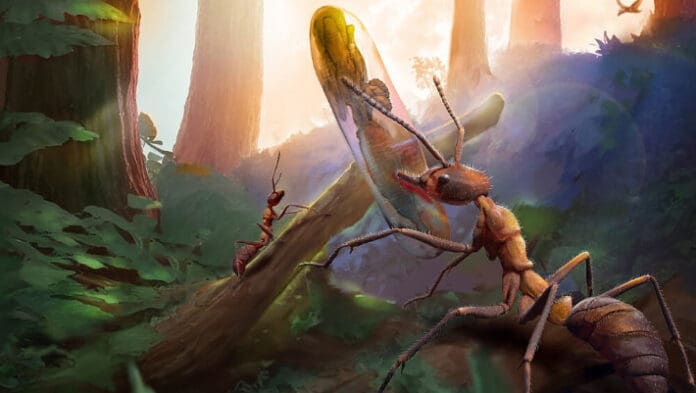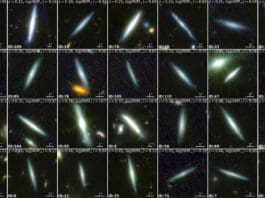These fossil fungi from mid-Cretaceous Kachin amber are from the same family as the zombie-ant fungus Ophiocordyceps unilateralis, which has gained widespread recognition as the inspiration behind the popular post-apocalyptic video game and TV series, The Last of Us.

Ecological reconstruction of Cretaceous insects and insect-pathogenic fungi. An ant is discarding an infected pupa, and an infected fly is located on a distant tree trunk. Image credit: Zhuang et al., doi: 10.1098/rspb.2025.0407.
The two new species, named Paleoophiocordyceps gerontoformicae and Paleoophiocordyceps ironomyiae, are among the oldest fossil records of animal-pathogenic fungi.
They were found in pieces of 99-million-year-old (mid-Cretaceous) Kachin amber collected from a mine near Noije Bum Village in northern Myanmar.
“Insects and fungi are among the most diverse groups of organisms, and they have coexisted for over 400 million years in terrestrial ecosystems,” said Professor Edmund Jarzembowski, a paleontologist at the Nanjing Institute of Geology and Palaeontology and the Natural History Museum, London, and his colleagues.
“As a result, they have evolved complex and intimate ecological relationships with each other, such as mutualism, predation and parasitism.”
“Entomopathogenic fungi (insect-pathogenic fungi) in particular have received attention as regulators of insect populations, although the majority of them remain unknown.”
“Infection starts with a spore that comes in contact with a suitable host, starts to germinate and bores through the cuticle layers via enzymatic hydrolysis, reaching the insect body cavity (haemocoel).”
“Once the insect body is penetrated, the fungus (at this stage as yeast-like cells) proliferates by budding and consumes the insect body from inside.”
“After some time, the insect is normally killed by fungal toxins and the yeast-like cells form chains, switching to the filamentous stage shortly after the host’s death.”
“These filaments will then gradually become organized into compact spore-producing structures (sporocarps) that will emerge from the insect’s soft parts, spreading the spores in the environment and eventually infecting other hosts.”

Holotype of Paleoophiocordyceps ironomyiae from mid-Cretaceous Kachin amber and the comparison with extant Ophiocordyceps fungi: (a, b) overall view in lateral and dorsal view of the dipteran host with the putative fungal structure emerging laterally; (c) close-up of fungal stroma of Paleoophiocordyceps ironomyiae; (d, e) apex of fungal stroma; red arrows indicate perithecia; (f-h) extant Ophiocordyceps stroma on ant (f) and dipteran (g, h) hosts. Scale bars – 0.5 mm (a, b), 0.1 mm (c) and 50 μm (d, e). Image credit: Zhuang et al., doi: 10.1098/rspb.2025.0407.
According to the authors, Paleoophiocordyceps gerontoformicae was found on a young ant, and Paleoophiocordyceps ironomyiae was found on a fly.
“It’s fascinating to see some of the strangeness of the natural world that we see today was also present at the height of the age of the dinosaurs,” Professor Jarzembowski said.
“It is known as the zombie-ant fungus because it can manipulate the behavior of its hosts as seen in the popular post-apocalyptic video game and TV series, The Last of Us.”
“As the infections are lethal, Ophiocordyceps and its fossil relatives likely played an important role in controlling the populations of insects by the mid-Cretaceous, in a similar way to how their living counterparts do today.”
“Although parasitic fungi are widespread in today’s ecosystems, finding fossil evidence of them is rare.”
“This is because their soft tissues do not preserve well in fossils, and as they live within a host, they can be difficult to identify among the insect remains.”
“Very few specimens of ancient parasitic fungi have been discovered, and so little is known about their evolution.”
“This latest discovery offers a rare glimpse into these parasites from a very long time ago.”
The team’s paper was published in the June 2025 issue of the Proceedings of the Royal Society B: Biological Sciences.
_____
Yuhui Zhuang et al. Cretaceous entomopathogenic fungi illuminate the early evolution of insect-fungal associations. Proc. R. Soc. B 292 (2048): 20250407; doi: 10.1098/rspb.2025.0407



